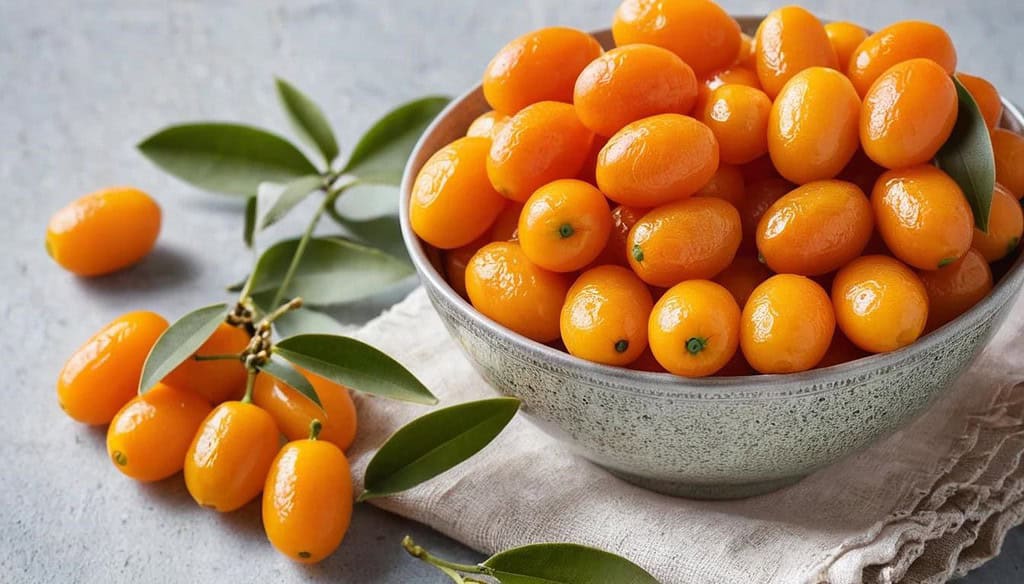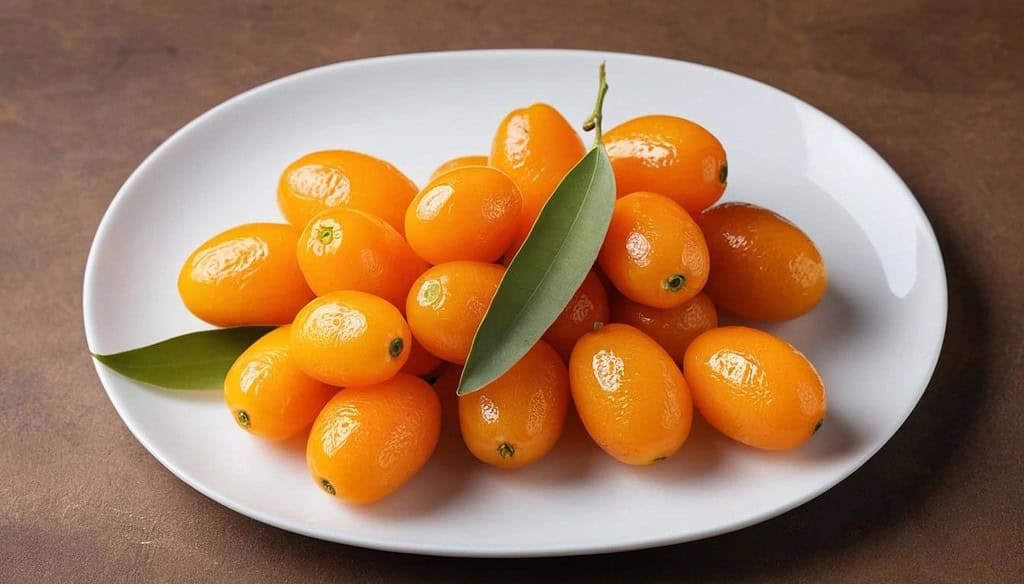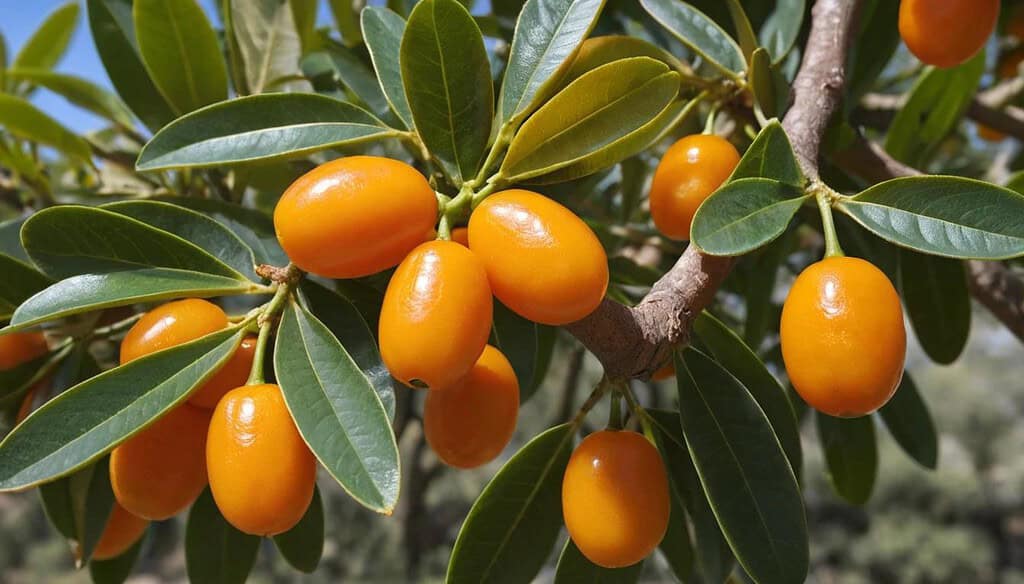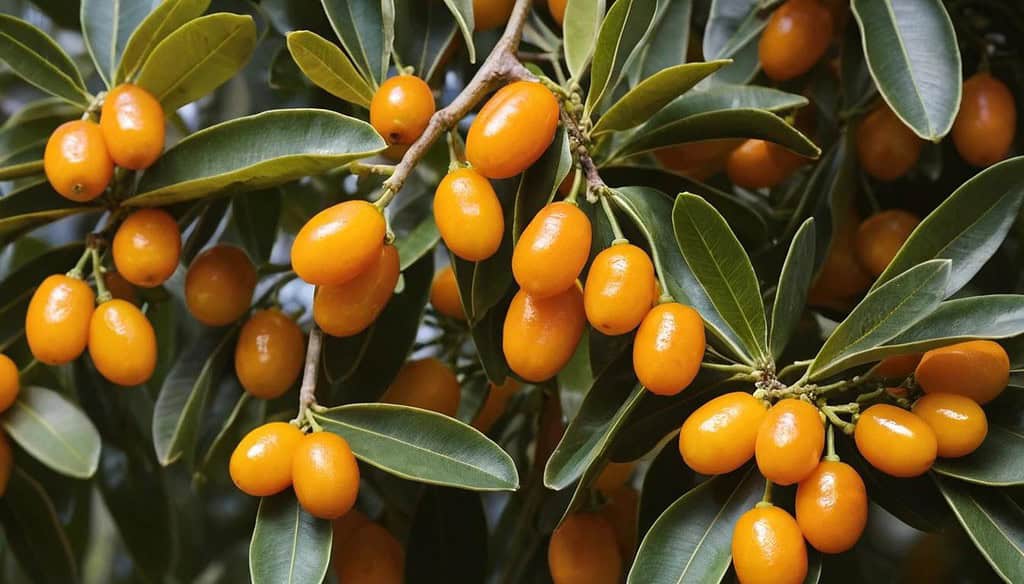Table of Contents
Kumquat: A Tiny Citrus with a Big Story to Tell

Kumquats are one of those fruits that don’t just surprise you—they captivate you. They may be small enough to fit in the palm of your hand, but the burst of flavor they bring is anything but tiny. If you’ve never tasted one, imagine biting into a fruit that combines the sweetness of an orange with the tang of lemon, all wrapped in delicate, edible skin. I’ll admit, the first time I tried a kumquat, I was taken aback. It was one of those “aha” moments when I realized that something so small could pack such a punch. It made me think—sometimes the most unassuming things carry the most fascinating stories.
What makes kumquats even more interesting is their scientific name, Citrus japonica, and their place in the Rutaceae family, a group of plants known for their fragrant citrus fruits. But here’s the kicker—kumquats have an edible skin! This is something I found truly amazing. You can eat the whole fruit, skin, and all, and it adds a delightful twist to the experience. The sweet skin balances the tart flesh inside, making it a citrus fruit unlike any other.
Kumquats might not always be the first fruit you grab when you’re browsing the produce section, but they have a rich history and an intriguing role in cultures around the world. Originating in China and other parts of Asia, kumquats have been cherished for centuries—not just for their unique flavor but also for their symbolic meaning. In Chinese culture, they’re often given as gifts during the Lunar New Year to wish for good luck and prosperity. Isn’t it incredible that such a humble fruit can carry so much meaning? It’s not just about what they represent, but how they bring joy to those special moments.
But it’s not just in Asia where kumquats have made an impact. Over the years, they’ve traveled the world, finding their way into kitchens across the Mediterranean, Southeast Asia, and even the U.S. There’s an entire festival dedicated to them in Florida, where locals celebrate their citrusy charm. From sweet tarts and marmalades to savory sauces and pickles, kumquats have become a global sensation.
What really fascinates me is how kumquats bridge tradition with modern creativity. While they’ve been part of traditional recipes for centuries, today’s chefs and home cooks are finding exciting ways to incorporate them into new dishes. Whether in a vibrant cocktail or as the star of a fresh salad, kumquats continue to inspire.
So, next time you see a kumquat, don’t just pass it by. Take a moment to enjoy it—you’re not just tasting a fruit, you’re experiencing a story. Trust me, it’s one you won’t forget.
The Global Journey of Kumquats: 8 Remarkable Tales

1. Kumquat in Lunar New Year Celebrations – A Symbol of Good Fortune
Kumquats are more than just fruits during the Lunar New Year celebrations—they’re a symbol of wealth, prosperity, and good fortune. In many Chinese households, these fruits are a traditional gift during the festival, as their bright orange color is believed to represent gold and wealth. These citrus fruits are presented as a way to wish someone good health and financial success in the coming year. The fruit’s compact size is also said to represent the idea of an abundant harvest, and it’s often placed in decorative arrangements alongside other lucky fruits like oranges and tangerines.
Not only are these citrus fruits gifted during the New Year, but they are also used in traditional dishes and drinks. One of the most famous examples is the “kumquat tea,” made by infusing these fruits in hot water. The slight bitterness of the fruit mixed with its natural sweetness is believed to bring balance to one’s life in the new year. Kumquat preserves and marmalade are also common treats, offering a delicious way to start the year with sweetness and prosperity.
Kumquats are a must at family gatherings for the Lunar New Year. As the elders passed the fruit around, they spoke of the good fortune that these citrus delights would bring into their lives. This cultural practice shows just how deeply embedded these fruits are in the traditions that honor both the present and the future, making them far more than mere fruits but a symbol of hope and abundance.
2. Kumquats in Japanese Cuisine – A Zesty Addition to Sushi
While many people associate kumquats with traditional desserts or tangy marmalades, their place in Japanese cuisine is just as fascinating. In Japan, these fruits are a delightful addition to sushi, offering a citrusy kick that complements the delicate flavors of the fish. The use of citrus in Japanese cooking is well-known—think yuzu, sudachi, or kabosu—and kumquats follow suit by adding a fresh, tangy contrast to the rich umami flavors of sushi.
The memory of having kumquat sushi at a local Japanese restaurant was surprisingly still refreshing. The kumquat slices, thinly placed on top of the sushi, offered a burst of citrus flavor that balanced the saltiness of the soy sauce and the smoothness of the fish. Whether in a traditional maki roll or atop nigiri, these fruits enhance the freshness of the dish. They are also used to add a zesty kick to dipping sauces or as a garnish for Japanese rice dishes, providing an added layer of flavor that surprises and delights the palate.
What makes these citrus fruits stand out in Japanese cuisine is their versatility. They are often served raw, where their entire skin is eaten along with the pulp, offering a unique texture and flavor combination. Their edible peel adds a touch of bitterness, which harmonizes with the sweetness of the fruit. In a world where food is both art and tradition, kumquats fit beautifully into the Japanese culinary landscape, offering a citrus burst that elevates the dining experience.
3. Kumquats in Mediterranean Cooking – A Citrus in Savory Dishes
When considering Mediterranean cuisine, one often envisions colorful salads, fresh seafood, and flavorful meats. However, the incorporation of kumquats in savory Mediterranean dishes may be unexpected. These citrus fruits enhance a range of meals, from lamb to chicken, by introducing a delightful citrus element. In Mediterranean culinary practices, kumquats are frequently utilized to complement the richness of meaty flavors with their tangy and subtly sweet characteristics.
One of the most talked about Mediterranean dishes with kumquats is a kumquat-glazed lamb. The marinade, made with these fruits, garlic, and herbs like rosemary, creates a perfect blend of acidity and sweetness that beautifully complements the richness of the lamb. The fruit’s bright, citrus flavor works wonders with robust meats, infusing them with a refreshing lift. Additionally, these fruits are sometimes sliced thin and scattered over roasted vegetables or grilled fish, where their tartness pairs excellently with the smokiness and earthiness of the dishes.
What makes kumquats especially suited to Mediterranean cooking is their balance of sweet and sour flavors, which pair well with the region’s love for fresh ingredients and bold flavors. Whether they’re used in stews, braised meats, or as a garnish, these fruits add a touch of innovation to traditional Mediterranean fare. They are a perfect example of how a small, humble fruit can make a big impact in elevating the flavors of Mediterranean dishes.
4. Kumquats in Marmalade – A Classic Spread with a Twist
Marmalade is a beloved classic spread, often made from oranges, but when you swap out the typical citrus for kumquats, you get something truly special. Kumquat marmalade is not only a treat for the taste buds but also a delightful twist on a well-known preserve. I’ve tasted kumquat marmalade several times, and I have to say, there’s something wonderfully satisfying about its combination of tangy bitterness and sweet citrus flavor. The small size of these citrus fruits means that their peel can be used in the marmalade, adding a slightly bitter bite that complements the sweetness of the fruit.
Making kumquat marmalade is an easy yet sophisticated way to enjoy this fruit. You simply simmer them whole with sugar and water, allowing the fruit’s natural pectin to thicken the mixture. The result is a spread that works wonderfully on toast, crackers, or as a topping for pancakes and waffles. What sets kumquat marmalade apart is its refreshing, zesty taste that feels like a burst of sunshine in a jar. I often find that kumquat marmalade pairs perfectly with sharp cheeses like goat cheese or cheddar, creating a balance of flavors that’s both savory and sweet. It’s also a great addition to desserts, adding an extra layer of citrusy sweetness to cakes and pastries.
For those who love to experiment with new flavors, kumquat marmalade offers a unique take on a classic favorite. It’s a way to enjoy these amazing citrus fruits in their purest form, letting their natural flavor shine in every jar.
5. Kumquats in Cocktails – A Citrusy Twist to Your Drink
Kumquats aren’t just for food—they make fantastic additions to cocktails as well. Whether you’re enjoying a simple gin and tonic or getting adventurous with a more complex concoction, these fruits can bring a citrusy zing that enhances any drink. The balance of sweet and sour notes makes them the perfect citrus fruit for mixing.
Kumquat Mojito is quite popular and well-known. The fruit adds a punch of flavor that elevates the usual lime-based cocktail, and the result is a refreshing, zesty drink that’s perfect for any occasion. These tangy citrus fruits are also used in margaritas, where their tartness offers a refreshing alternative to the usual lime. You can muddle them along with mint or herbs, allowing their juices to blend into the cocktail base, creating a beautifully layered drink.
What’s great about kumquats in cocktails is that they’re incredibly versatile. They work with many spirits, from rum and tequila to vodka and gin, and their bite adds a delightful complexity to the drink. Whether you’re a fan of fruity drinks or prefer something more balanced, these citrus fruits can give your cocktails a unique and unexpected twist.
6. Kumquats in Desserts – A Sweet and Tart Finale
Kumquats shine in the world of desserts, where their sweet and tart flavor brings a refreshing complexity to cakes, tarts, and sorbets. Their small size and unique flavor profile make them perfect for dessert recipes that require a touch of citrus without overpowering the sweetness. The kumquat sorbet is fascinating. The balance between its tangy bite and smooth sweetness was nothing short of magical. Kumquat-infused ice creams are also a treat, offering a fresh, light alternative to traditional heavy desserts.
In tarts, these citrus delights add an unexpected yet delightful twist. Their tangy citrus flavor is complemented by a buttery, flaky crust and a sweet filling, creating a dessert that’s both refreshing and satisfying. Kumquat curd, often used as a filling for pastries or spread on toast, is another fantastic dessert option. The fruit’s natural acidity adds a bright note that cuts through the sweetness, creating a balanced, flavorful treat.
For those looking to explore new ways to use these citrus fruits in desserts, consider using them in fruit salads, where their sweet-tart notes can blend perfectly with other fruits like berries, apples, or pomegranates. These fruits also work well in fruit compotes, jams, and jellies, where their bright flavor adds a lively kick to any dessert spread.
7. Kumquats in Traditional Remedies – A Healthy Boost for Body and Mind
Beyond their culinary uses, kumquats have a long history in traditional medicine, particularly in Asia. For centuries, they have been used to treat various ailments, and their health benefits continue to be appreciated today. They are rich in vitamin C, making them a popular remedy for boosting the immune system, especially during cold and flu season. In rainy and winter seasons, many people brew kumquat tea to help with coughs and sore throats, as the fruit’s natural properties are believed to soothe the respiratory system.
The fruit’s high antioxidant content is also praised for its ability to fight free radicals, which can contribute to aging and various health issues. These fruits are known to promote digestive health, and their fiber content can help with constipation and bloating. People also use kumquat oil in aromatherapy, where it’s believed to have a calming effect on the mind and body. The refreshing scent is thought to uplift the mood and improve focus, making it a popular ingredient in essential oil blends.
For those looking to improve their skin, these citrus fruits are often included in skincare routines for their vitamin C content, which can help reduce wrinkles and brighten the complexion. With all these health benefits, kumquats offer far more than just a tasty treat—they’re a natural remedy for overall wellness, whether consumed in food, tea, or even skincare products.
8. Kumquats Around the World – A Journey Across Continents
Kumquats are not just a staple in one region; their journey around the world is as vibrant as the fruit itself. Native to Southeast Asia, kumquats have spread to various parts of the world, with distinct variations and uses emerging in each culture. In the United States, they are often found in the southern states, where they thrive in warmer climates. They are commonly used in jams, marmalades, and fresh fruit salads, often celebrated for their unique sweet-tart flavor.
In Europe, particularly in countries like Italy and Spain, these fruits are used to make delicious liqueurs like “Kumquat Liqueur” in Italy, where the fruit is steeped in alcohol and sugar to create a flavorful digestif. In the Middle East, they are sometimes used in savory dishes, including stews and pickles, demonstrating their adaptability across diverse cuisines.
As kumquats continue to travel and evolve, they are becoming a popular fruit in markets around the world. In Australia, they’ve found a place in local kitchens, where they are used in both sweet and savory dishes, much like in Mediterranean cuisine. The fruit’s growing global presence reflects its versatility and appeal, making it a beloved ingredient in many countries. With each culinary tradition that embraces the fruit, kumquats’ ability to adapt and shine in different settings continues to impress.
Kumquats: Bridging Tradition and Modern Creativity

Kumquats are an extraordinary fruit that bridges the gap between tradition and modern creativity. While they are deeply ingrained in cultural practices and history, they also open up endless opportunities for innovation in contemporary cuisine and beyond. From their use in age-old remedies to their role in modern culinary techniques, these citrus delights symbolize the harmonious blend of past and present.
For centuries, these fruits have been cherished, particularly in Asian cultures, where they hold significance during festive seasons like the Lunar New Year, symbolizing good fortune and prosperity. Historically, they have been used in both food and medicine, prized for their unique balance of sweetness and tanginess, as well as their impressive array of vitamins. Even today, people turn to these fruits for their immune-boosting properties, with some even using them to soothe sore throats or improve digestion.
In recent years, the culinary world has embraced these citrus delights in fresh and inventive ways, making them a key element of modern creativity. In fusion cuisine, they make appearances in unexpected dishes. Their bright, zesty flavor complements everything from savory meats to refreshing drinks. I’ve witnessed chefs using these fruits in gourmet salads, where their tangy kick balances out the richness of creamy dressings or the sharpness of cheeses. In the world of mixology, kumquat-infused cocktails, like the kumquat mule or kumquat gin, add a delightful burst of flavor, enhancing the drink’s profile with a unique blend of sweet and sour notes.
These citrus fruits have also carved out a place for themselves in the world of modern innovation, especially in beauty and wellness. In skincare, their high vitamin C content is prized for its antioxidant effects, brightening the skin and fighting signs of aging. Similarly, in aromatherapy, kumquat oil is gaining popularity for its uplifting, refreshing scent, providing a natural energy boost in essential oil blends.
What makes these fruits so special is their versatility. They serve as a link between the old and new, offering a deep connection to tradition while inspiring fresh creativity. Whether enjoyed in a classic dish or incorporated into a contemporary recipe, kumquats demonstrate how the past and present can blend seamlessly, turning ordinary experiences into something extraordinary.
Ancient Orchards to Modern Tables: Kumquat’s Timeless Allure

From the ancient orchards where these fruits first flourished to the modern tables where they now shine, kumquats have maintained a timeless allure that continues to captivate people across the world. These citrus delights have managed to retain their charm through the ages, evolving from a cherished fruit in traditional cultures to a trendy ingredient in today’s innovative cuisine. Their journey is a testament to their remarkable versatility and enduring appeal.
Originating in Southeast Asia, these fruits have been a part of human history for centuries, valued for their unique combination of sweetness and tartness. Ancient civilizations recognized their potential, using them not only as a food source but also for medicinal purposes. Over the years, they spread across different continents, becoming a symbol of prosperity and good fortune, particularly in East Asian cultures. In the present day, they have woven themselves into a vast array of culinary traditions, showing that their charm is as relevant today as it was thousands of years ago.
The way these fruits have adapted to modern culinary trends further illustrates their timeless appeal. Their adaptability to both sweet and savory dishes, along with their growing use in beverages and even skincare, speaks to the diverse ways in which people now enjoy them. The flavor profile of kumquats—bold and fresh, with a hint of tanginess—makes them a favorite among chefs and home cooks alike, who continue to explore new ways to showcase their vibrant essence. The ability of these citrus delights to transcend boundaries, blending seamlessly into traditional and contemporary recipes, ensures that their popularity remains as strong as ever.
What truly sets these fruits apart is their enduring presence in the cultural and culinary fabric of so many societies. As ancient as they are, they continue to inspire creativity, while also serving as a reminder of the traditions they come from. Whether found in a traditional Lunar New Year feast or an experimental gourmet dish, kumquats are a fruit that continues to resonate with people, bridging the gap between the past and the present. In a world that constantly seeks the new and the novel, these fruits remain a symbol of timeless appeal, bringing a touch of history and a burst of flavor to every dish they touch.
Disclaimers: *This article is only for informational purposes.
**Do not make your important decisions solely based on the information provided in this article. Do your own research.
***Consult a doctor or a medical professional in case of a medical emergency.
****Information in this article may vary or get updated in the future.
Read More Science and Space Articles
- Beautiful Art of Gravity: 8 Ways It Shapes Our Daily Lives
- Big Bang: 8 Explosive Steps to Derive The Recipe of Cosmos
- 8 Amazing Lime Tales: Ancient Groves to Modern Kitchens
- 8 Weird Ways Grapefruit Can Interfere with Medications
- Pomelo in Culture: 8 Heartwarming Ritual Traditions
- 8 Culinary Uses of Oranges That I Highly Recommend
- 8 Astounding Ways Lemons Have Helped Elevate My Mood
- 8 Irresistible Ericaceae Fruits (Heath Family) to Savor and Enjoy
- 8 Incredible and Healthy Cucurbitaceae Fruits to Enjoy
- Top 8 Delicious Anacardiaceae Fruits You Must Try
- 8 Incredible Musaceae Fruits You Need to Try Right Now
- 8 Incredible Vitaceae Fruits: Nature’s Tasty Treasures
- 8 Incredible Rosaceae Fruits You Need to Discover
- Discover 8 Fruit Families That Enrich Our Daily Diets
- 8 Non-CO₂ Greenhouse Gasses That Are Worst Than CO₂
- 8 Ways Water Crisis is Worsened by Global Climate Change
- 8 Amazing Ways Brain Anatomy is Altered by New Learning
- 8 Disastrous Ways Deforestation Destroys Biodiversity
- 8 Worst Ways Global Climate Change Hurts The Impoverished
- Danger Of Environmental Damage: 8 Ways A Person Can Help
- Eradication Of Poverty: 8 Critical Ways Science Helps
- Mathematics: 8 Interesting Ways To Become Efficient At It
- STEM Fields: 8 Important Reasons Why You Must Learn Them
- Making Your Kid Efficient At STEM Subjects: 8 Important Steps
- Becoming A NASA Aspirant: 8 Important Steps You Must Follow
- Discoveries by JWST: 10 Incredible Findings of The Telescope
- NASA’s MOXIE Creates O2: Big Step Towards Mars Colonization
- Space Science: 6 Vital Reasons Why We Should Invest in It
- Solar System: 10 Astonishing Uniqueness of our star system




